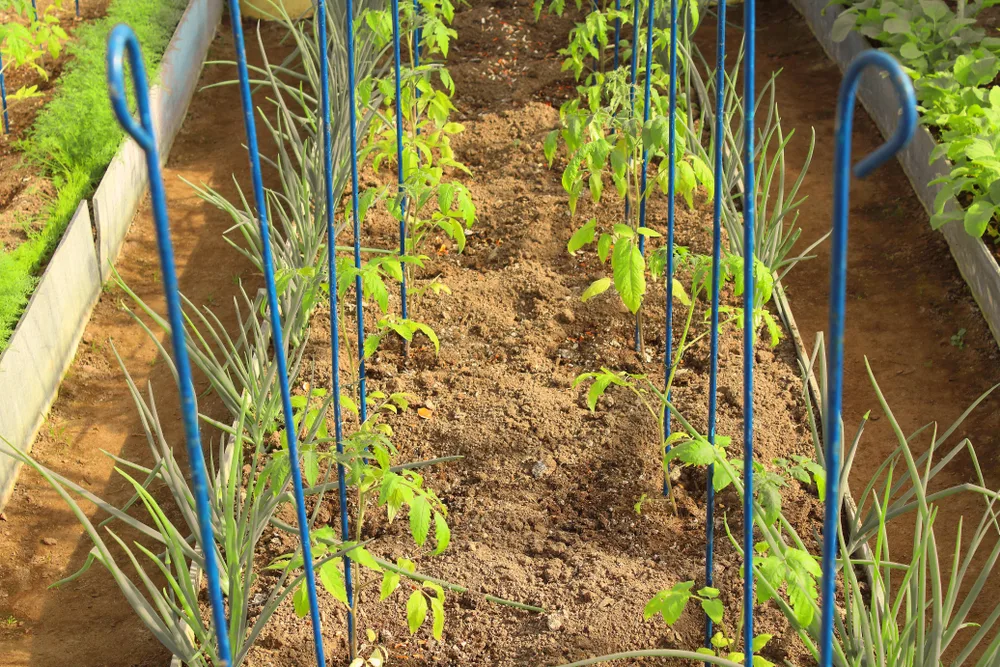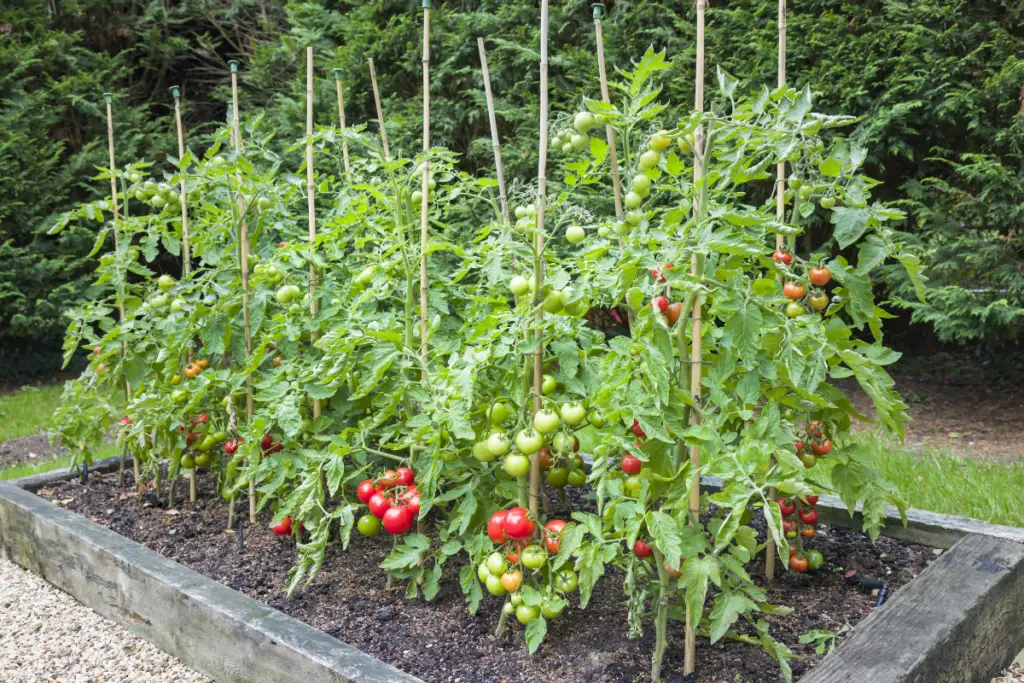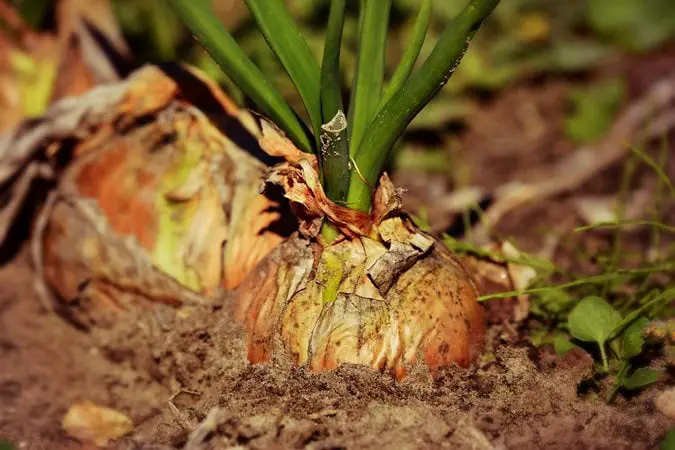The article “Can You Plant Onions With Tomatoes” explores the fascinating relationship between these two popular garden staples. This article delves into the potential benefits and drawbacks of planting onions alongside tomatoes in your garden. By examining the scientific principles of companion planting and the unique characteristics of these vegetables, it aims to provide readers with a comprehensive understanding of whether or not these two plants can thrive together. Whether you’re a seasoned gardener or just starting your green thumb journey, this article will offer valuable insights on maximizing the potential of your garden.

Benefits of Planting Onions with Tomatoes
Planting onions with tomatoes offers several benefits that can enhance the growth and overall productivity of both plants. This companion planting approach allows for the efficient utilization of available garden space, maximizes nutrition uptake, and helps in preventing the spread of pests and diseases. Additionally, planting onions with tomatoes can enhance the flavor of tomatoes, making them even more delicious when used in various culinary preparations. This article will explore the factors to consider before planting onions with tomatoes, the necessary preparations, the planting process itself, ways to care for these plants, harvesting techniques, complementary planting options, common problems and solutions, as well as the nutritional benefits of onions and tomatoes. Some mouthwatering recipes using onions and tomatoes will also be shared to inspire you to make the most of your harvest.
Factors to Consider Before Planting Onions with Tomatoes
Compatibility of Onion and Tomato Varieties
Before embarking on your planting journey, it is crucial to consider the compatibility of onion and tomato varieties. Some varieties of onions and tomatoes thrive better together while others may hinder each other’s growth. It is advisable to choose onion and tomato varieties that have similar growth requirements and durations to ensure healthy coexistence.
Space Requirements
Both onions and tomatoes require sufficient space for optimal growth. Onions generally have a smaller above-ground structure compared to tomatoes, making them suitable for interplanting. However, their roots will still need ample space for efficient nutrient absorption. Consider the growth habits of both plants and plan your garden space accordingly to avoid overcrowding and stunting their growth.
Growing Conditions
Onions and tomatoes have varying preferences for growing conditions, including temperature, sunlight exposure, and soil type. It is important to select varieties that thrive in similar conditions to ensure their compatibility. Additionally, assess your garden’s microclimate and make any necessary adjustments to provide optimal conditions for both plants’ growth.
Pest and Disease Management
Pests and diseases can pose significant threats to onion and tomato crops. Before planting onions with tomatoes, familiarize yourself with the common pests and diseases that affect both plants and develop a comprehensive pest management plan. Consider using natural remedies and biological controls to minimize chemical intervention and maintain a healthy ecosystem in your garden.

Preparation before Planting Onions with Tomatoes
Selecting Suitable Onion and Tomato Varieties
To ensure a successful companion planting endeavor, it is crucial to select suitable onion and tomato varieties that are compatible in terms of growth requirements, disease resistance, and flavor characteristics. Consult with local gardening experts or reputable seed suppliers to identify suitable varieties for your specific region and climate.
Soil Preparation
Prepare the soil adequately before planting onions and tomatoes to create a nutrient-rich and well-draining environment. Test the soil pH and make necessary amendments to optimize its suitability for both crops. Incorporate organic matter, such as compost or well-rotted manure, to enrich the soil and improve its structure. Remove any weeds or debris to create a clean planting bed, facilitating optimal growth conditions.
Companion Planting Strategies
Companion planting is an effective technique to maximize the benefits of planting onions with tomatoes. Some plants, when grown together, provide mutual benefits in terms of pest repulsion, nutrient sharing, and space utilization. Consider including companion plants, such as marigolds, basil, or parsley, in your garden layout to enhance the overall health and productivity of your onion and tomato crops.
Timing of Planting
Timing is crucial when planting onions with tomatoes. Both crops have specific planting windows for optimal growth and development. Onions are typically planted in early spring, while tomatoes thrive in warm, sunny conditions. Coordinate your planting schedule accordingly, taking into account the recommended planting times for each crop to ensure synchronized growth and successful companion planting.
Planting Onions with Tomatoes
Sequential Planting
Sequential planting involves staggering the planting of onions and tomatoes to optimize space and harvest times. Start by planting the onions first, allowing them to establish and reach a certain size before planting the tomatoes in the same bed. This approach ensures that both crops have ample space and resources without competing for nutrients and sunlight.
Interplanting
Interplanting refers to the practice of interspersing onion and tomato plants within the same garden bed. This method allows for efficient use of space and resource sharing. However, careful consideration should be given to the growth habits and spacing requirements of each plant to avoid overcrowding and hindered growth.
Planting Layouts
When planting onions and tomatoes together, there are various layouts that can be employed, depending on the available space and your preferred gardening style. Row planting, where onions and tomatoes are planted in parallel rows, or the square foot gardening method, which maximizes space utilization, are commonly used layouts. Choose the layout that suits your garden’s size and design while ensuring adequate spacing between plants.
Transplanting Seedlings
Both onions and tomatoes can be started from seeds indoors and then transplanted into the garden. Start the seedlings in trays or pots, providing the appropriate conditions for germination and early growth. When the seedlings have developed a strong root system and a suitable height, transplant them carefully into the prepared garden bed, taking care not to disturb the roots.

Caring for Onions and Tomatoes
Watering
Proper watering is essential for the healthy growth and development of onions and tomatoes. Both crops require consistent moisture throughout their growing periods. Ensure that the soil remains evenly moist, but not waterlogged, to prevent rot and disease. Water deeply and at the base of the plants to encourage deep root growth and reduce water evaporation.
Mulching
Mulching plays a vital role in maintaining favorable soil moisture levels, suppressing weed growth, and moderating soil temperatures. Apply a layer of organic mulch, such as straw or wood chips, around the base of the onion and tomato plants. This will help conserve moisture, deter weeds, and provide insulation to the roots during extreme temperature fluctuations.
Fertilizing
Onions and tomatoes have specific nutrient requirements that should be met to ensure vigorous growth and high yields. Prior to planting, incorporate a balanced organic fertilizer into the soil to provide essential nutrients. Additionally, regular fertilization throughout the growing season is recommended. Use a fertilizer specifically formulated for vegetables or follow soil test recommendations to avoid nutrient deficiencies or excesses.
Staking or Support Systems
Both onions and tomatoes benefit from support systems to maintain their upright growth and prevent sprawling. Stake the tomato plants using bamboo poles or cages to support the heavy fruits and ensure proper air circulation. Onions, although less likely to require staking, may benefit from support during inclement weather or when growing larger-sized varieties.
Regular Inspections
To prevent potential problems, it is essential to conduct regular inspections of your onion and tomato plants. Look for signs of pests, diseases, or nutrient deficiencies, and take necessary measures promptly. Regular inspections allow for early detection of issues, allowing for timely intervention and minimizing the risk of crop loss.
Harvesting Onions and Tomatoes
Harvesting Onions
Onions are typically ready for harvest when the tops have withered and begun to dry out. Carefully loosen the soil around the onion bulbs using a garden fork or trowel, being cautious not to damage the bulbs. Gently lift the onions from the ground and allow them to dry further in a warm, well-ventilated area before storing.
Harvesting Tomatoes
Tomatoes should be harvested when they have reached their desired stage of ripeness, depending on the variety. Most tomatoes are ready for harvest when they develop their characteristic color, firmness, and flavor. Use scissors or a sharp knife to carefully remove the fruits from the plant, taking care not to damage the surrounding stems or foliage.

Complementary Planting Options with Onions and Tomatoes
Planting Herbs
To further enhance the benefits of planting onions with tomatoes, consider incorporating herbs into your garden layout. Herbs like basil, thyme, or oregano not only add flavor to your culinary creations but also repel pests that may damage your onion and tomato crops. Their aromatic properties can deter unwanted insects, contributing to a healthier and thriving garden.
Growing Leafy Greens
Leafy greens, such as lettuce or spinach, can be grown alongside onions and tomatoes in the garden. These vegetables have similar growth requirements and complement each other well in terms of nutritional needs. Plus, having a variety of fresh greens readily available can increase the diversity and taste of your meals.
Intercropping with Beans or Peas
Intercropping onions and tomatoes with legumes, such as beans or peas, offers numerous advantages. The legumes fix nitrogen from the atmosphere, benefiting both onion and tomato plants that require this essential nutrient for healthy growth. Moreover, intercropping can help suppress weeds and provide a visually appealing garden with increased biodiversity.
Common Problems and Solutions
Competitive Growth
When planting onions with tomatoes, both plants may compete for resources, including nutrients, sunlight, and water. To prevent competition, ensure adequate spacing between plants and implement proper watering and fertilization practices. Regular maintenance, like pruning and training tomato plants to prevent overcrowding, can also alleviate competition and promote healthier growth.
Disease Management
Onions and tomatoes are susceptible to various diseases, such as fungal infections, blight, or rot. To mitigate the risk of disease, practice good sanitation by removing and destroying any infected plant material. Additionally, consider employing disease-resistant varieties and following proper crop rotation techniques to reduce the likelihood of recurring diseases.
Pest Management
Pests, including aphids, caterpillars, or mites, can damage both onion and tomato plants. Implement integrated pest management practices, such as regular inspections, natural predators, and organic pest control methods, to minimize pest populations. Keep your garden clean and clear of debris to discourage pest infestations and maintain a healthy ecosystem.

Nutritional Benefits of Onions and Tomatoes
Both onions and tomatoes are rich sources of essential nutrients and antioxidants. Onions are known for their high content of vitamin C, dietary fiber, and various beneficial compounds that contribute to heart health, immune support, and anti-inflammatory properties. Tomatoes, on the other hand, are packed with vitamins A, C, and K, as well as lycopene, which is associated with reduced risk of certain cancers and improved cardiovascular health. Including onions and tomatoes in your diet can greatly contribute to your overall well-being and provide a wide range of health benefits.
Delicious Recipes Using Onions and Tomatoes
To fully enjoy the flavors and versatility of onions and tomatoes, here are some delightful recipes to try:
Tomato and Onion Salad
Ingredients:
- Fresh tomatoes
- Red onions
- Fresh basil leaves
- Olive oil
- Balsamic vinegar
- Salt and pepper to taste
Preparation:
- Slice the tomatoes and onions into thin rounds.
- Arrange the tomato and onion slices alternately on a serving plate.
- Drizzle with olive oil and balsamic vinegar.
- Sprinkle with torn basil leaves.
- Season with salt and pepper to taste.
- Let the flavors marinate for a few minutes before serving.
Onion and Tomato Tart
Ingredients:
- Pie crust
- Yellow onions
- Cherry tomatoes
- Fresh thyme leaves
- Shredded cheese (such as Gruyere or mozzarella)
- Salt and pepper to taste
- Olive oil
Preparation:
- Preheat the oven to the temperature specified by the pie crust instructions.
- Roll out the pie crust and place it in a tart pan.
- Slice the onions into half-moons and sauté in olive oil until caramelized.
- Spread the caramelized onions evenly over the pie crust.
- Slice the cherry tomatoes in half and arrange them on top of the onions.
- Sprinkle with fresh thyme leaves, shredded cheese, salt, and pepper.
- Place the tart in the preheated oven and bake according to the pie crust instructions or until the cheese is melted and golden.
Roasted Tomato and Onion Soup
Ingredients:
- Ripe tomatoes
- Yellow onions
- Garlic cloves
- Olive oil
- Vegetable broth
- Fresh basil leaves
- Salt and pepper to taste
Preparation:
- Preheat the oven to 400°F (200°C).
- Cut the tomatoes and onions into quarters.
- Toss the tomatoes, onions, and garlic cloves in olive oil and season with salt and pepper.
- Arrange the vegetables on a baking sheet and roast in the preheated oven for approximately 30 minutes or until they are caramelized.
- Transfer the roasted vegetables to a blender or food processor.
- Add vegetable broth and fresh basil leaves.
- Blend until smooth.
- Transfer the mixture to a pot and heat over medium heat until warmed through.
- Season with additional salt and pepper if desired.
- Serve hot and garnish with fresh basil leaves.
Enjoy these flavorful recipes that highlight the deliciousness of onions and tomatoes while incorporating them in creative and nutritious ways.
In conclusion, planting onions with tomatoes can bring numerous benefits to your garden, including efficient space utilization, improved pest and disease management, and enhanced flavor profiles. By considering factors like variety compatibility, space requirements, growing conditions, and pest management, you can ensure successful companion planting. Adequate preparation, including soil enrichment, companion planting strategies, and proper timing, is crucial for the healthy development of both crops. Caring for onions and tomatoes involves providing sufficient water, mulching, fertilizing, and implementing support systems. Harvesting onions and tomatoes requires careful observation of maturation signs and gentle handling of the crops. Furthermore, integrating complementary plants like herbs, leafy greens, or legumes can enhance the overall resilience and productivity of your garden. Be proactive in identifying and addressing common problems such as competitive growth, diseases, and pests. Finally, savor the nutritional benefits of onions and tomatoes by incorporating them into your diet through a range of delectable recipes.



